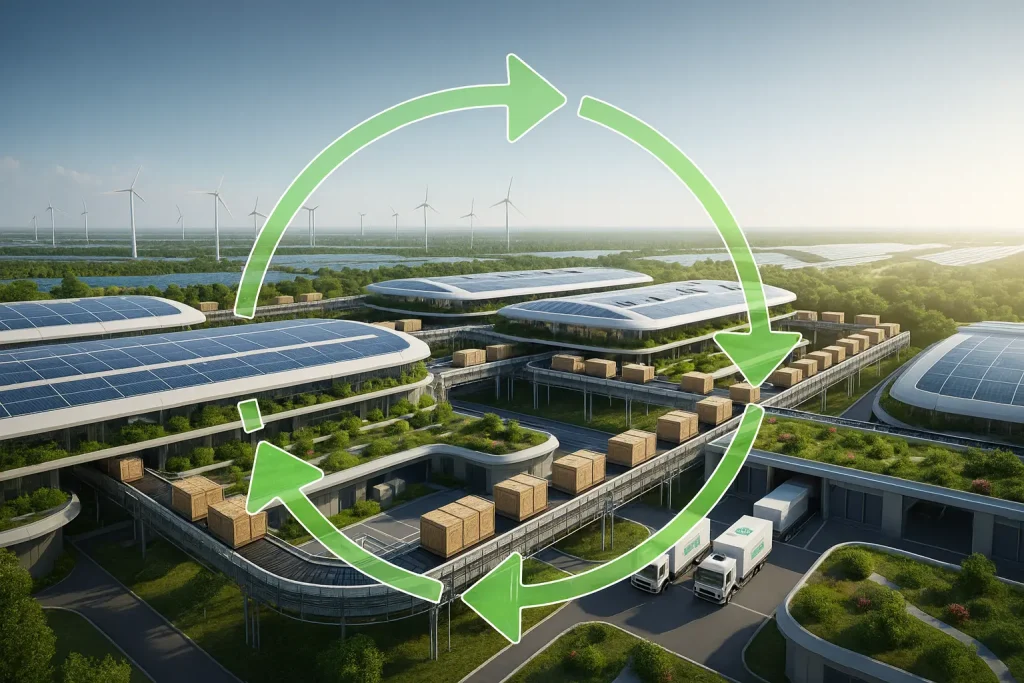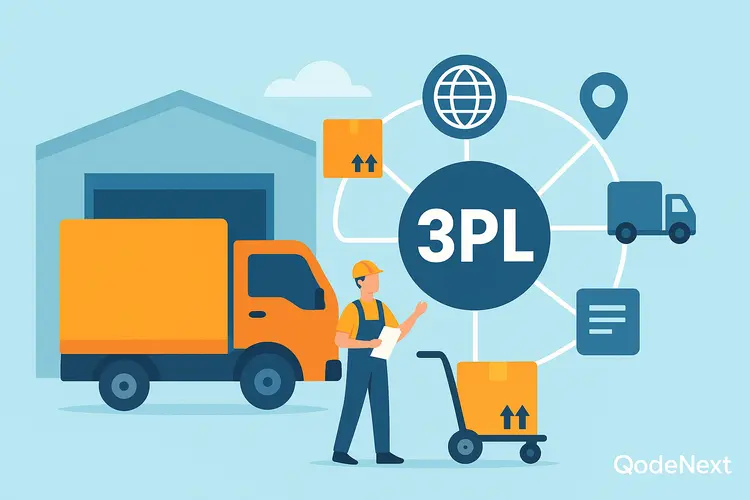Sustainable printing allows suppliers to produce high-quality labels with minimal environmental impact. Green printing uplifts a company’s credentials, helping it earn good investor ratings. It also helps save costs and minimize packaging waste with zero effect on quality.
Are you interested in eco-friendly printing? Let’s explore seven green printing methods, including their features, benefits, and more.
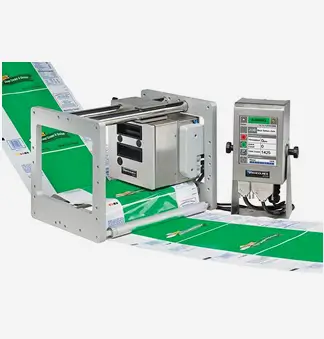
What Is Sustainable Printing?
Sustainable printing refers to eco-friendly practices that minimize environmental harm during the printing process. This approach focuses on reducing waste, using renewable resources, and conserving energy, while still producing high-quality printed materials. It encompasses techniques, materials, and technologies that lower the carbon footprint.
7 Best Sustainable Printing Methods
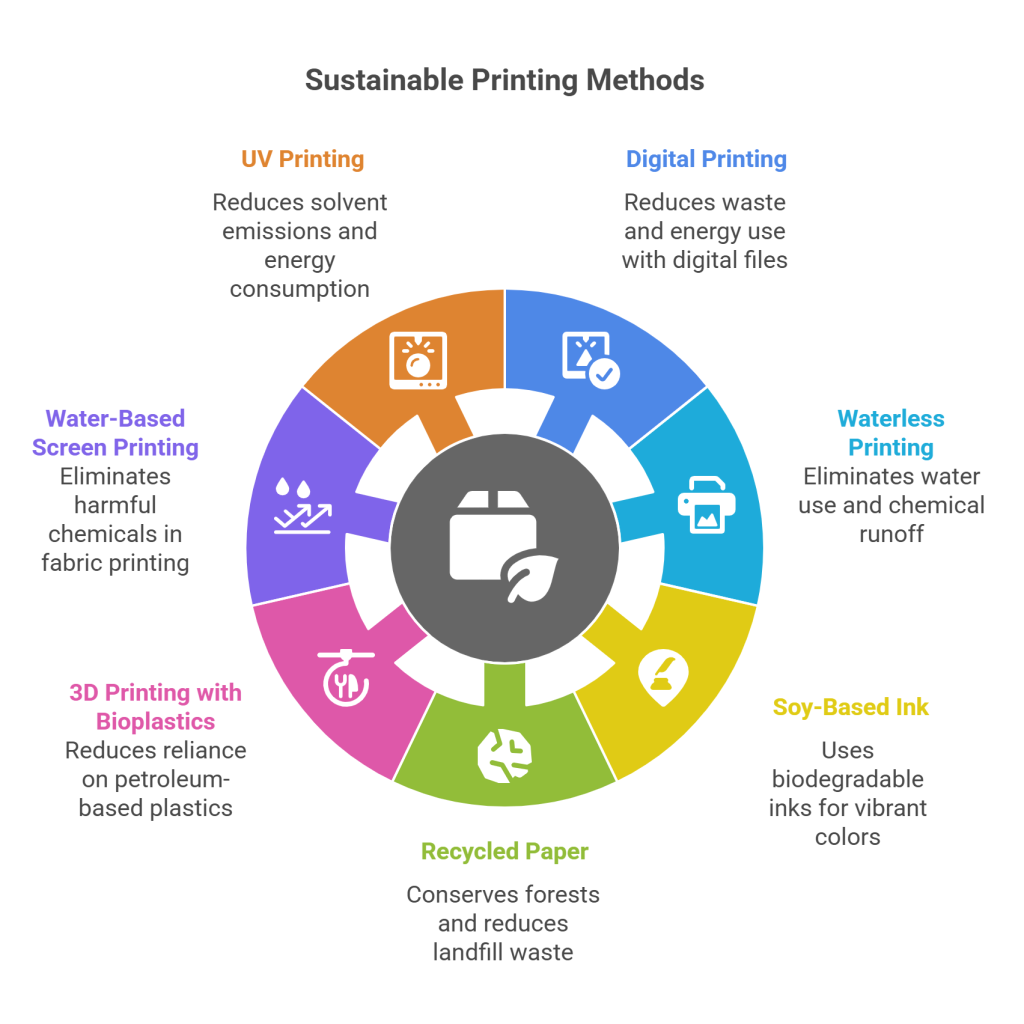
1. Digital Printing
Digital printing is one of the most eco-friendly methods. It eliminates the need for printing plates, reduces waste, and uses energy-efficient technologies.
Features:
- Prints directly from digital files.
- No prepress setup is required.
- Supports small and large-scale printing needs.
Benefits:
- Minimises waste since no plates or extra materials are used.
- Ideal for print-on-demand, reducing unnecessary inventory.
- Saves energy by streamlining the printing process.
2. Waterless Printing
This method eliminates the need for water in the printing process, using silicone-coated plates and specialised inks instead.
Features:
- Avoids water and dampening solutions.
- Produces high-quality images.
- Uses eco-friendly inks.
Benefits:
- Reduces water consumption significantly.
- Prevents harmful chemical runoff into the environment.
- Ensures consistent, high-resolution print quality.
3. Soy-Based Ink Printing
Traditional petroleum-based inks are replaced with soy-based alternatives, which are biodegradable and safer for the environment.
Features:
- Uses soybean oil as the primary ingredient.
- Available in vibrant colour options.
- Compatible with various printing technologies.
Benefits:
- Reduces VOC (Volatile Organic Compound) emissions.
- Easier to recycle compared to petroleum-based inks.
- Provides rich, vivid colours with lower environmental impact.
4. Recycled Paper Printing
Printing on recycled paper reduces the demand for virgin materials, conserving forests and reducing waste. It promotes sustainable printing on demand.
Features:
- Uses paper made from post-consumer or pre-consumer waste.
- Available in a variety of finishes and textures.
- Works seamlessly with modern printers.
Benefits:
- Conserves natural resources like trees and water.
- Reduces landfill waste and energy consumption.
- Encourages the recycling industry and circular economy.
5. 3D Printing with Bioplastics
3D printing is already an innovative technology, but using biodegradable or recycled bioplastics makes it even more sustainable.
Features:
- Utilizes plant-based materials like PLA (polylactic acid).
- Ideal for creating prototypes and models.
- Requires minimal material waste.
Benefits:
- Reduces reliance on petroleum-based plastics.
- Produces minimal waste compared to traditional manufacturing.
- Promotes eco-friendly innovation in multiple industries.
6. Screen Printing with Water-Based Inks
This is the best sustainable fabric printing method. Screen printing traditionally uses plastisol inks, which contain harmful PVC. Switching to water-based inks makes this method more sustainable.
Features:
- Utilizes water-soluble inks.
- Offers a soft, breathable print finish.
- Suitable for textiles and other materials.
Benefits:
- Eliminates the use of harmful chemicals and PVC.
- Produces prints with a soft texture and high durability.
- Reduces environmental impact, especially for clothing brands.
7. UV Printing
UV printing involves curing ink using ultraviolet light, eliminating the need for solvents and reducing drying time.
Features:
- Uses instant-drying UV-cured inks.
- Works on a wide range of materials.
- Delivers sharp and vibrant prints.
Benefits:
- Eliminates harmful solvent emissions.
- Reduces energy consumption due to faster drying.
- Suitable for eco-conscious businesses requiring high-quality results.
Features of Sustainable Printing
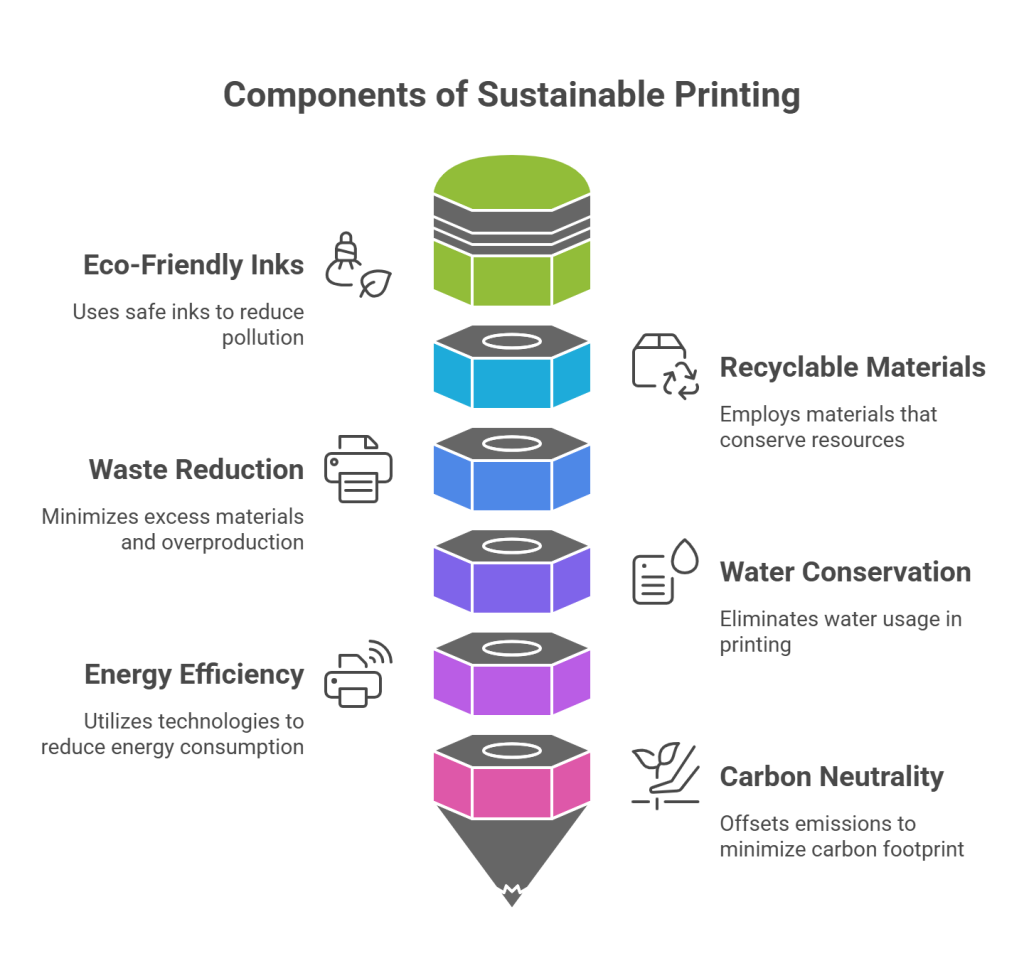
1. Use of Eco-Friendly Inks
Sustainable printing practices use environmentally safe inks such as soy-based, water-based, or vegetable-based inks. These inks are free from harmful chemicals like Volatile Organic Compounds (VOCs), which are present in traditional petroleum-based inks. As a result, they reduce air pollution, minimize toxic waste, and promote safer handling during the printing process.
2. Focus on Recyclable and Biodegradable Materials
A hallmark of printing is the use of recyclable and biodegradable substrates, such as recycled paper, cardboard, or plant-based plastics. These materials reduce the demand for virgin resources like wood pulp and petroleum-based products, helping conserve natural resources while reducing the amount of waste sent to landfills.
3. Reduction of Printing Waste
Sustainable printing technologies, like digital and 3D printing, minimize excess materials such as plates, films, and unused ink. Additionally, on-demand printing eliminates overproduction by allowing users to print only what is necessary, reducing waste and the need for large inventories.
4. Water Conservation
Waterless printing is a revolutionary approach that eliminates the use of water in the printing process. Traditional printing methods require water for dampening solutions, which can lead to significant water consumption and chemical runoff. By adopting waterless alternatives, printers can drastically reduce water usage and prevent environmental contamination.
5. Energy-Efficient Technologies
Modern printing methods use energy-efficient equipment designed to minimize power consumption without compromising productivity. UV printing, for example, cures inks instantly using ultraviolet light, reducing drying times and energy usage. Similarly, digital printing eliminates many energy-intensive steps involved in traditional offset printing.
6. Carbon-Neutral Processes
Sustainable printing companies often aim to achieve carbon neutrality by offsetting their emissions through initiatives such as reforestation or renewable energy investments. This ensures that the carbon footprint of the printing process is minimized or completely neutralized, making the operation environmentally responsible.
Benefits of Sustainable Printing
Sustainability in the printing industry will become a case study for innovative solutions. Here are its potential benefits:
1. Environmentally Friendly Practices
Sustainable printing minimizes environmental impact by reducing waste generation, conserving natural resources such as water and trees, and lowering greenhouse gas emissions. It employs eco-friendly materials like recycled paper and vegetable-based inks, while also utilizing energy-efficient machines that consume less power and use fewer harmful chemicals, thus preventing pollution and promoting a healthier ecosystem.
2. Cost Efficiency
Though some sustainable printing materials and technologies may have higher upfront costs, their use leads to significant savings over time by minimizing waste, lowering energy consumption, and reducing material usage. Efficient production processes cut down on reprints and errors, and the decreased energy requirements contribute to lower utility bills, making sustainable printing economically viable in the long run.
3. Improved Brand Image
Companies adopting green printing practices demonstrate corporate social responsibility and a commitment to sustainability, resonating positively with environmentally conscious customers and stakeholders. Such eco-friendly initiatives help enhance brand loyalty, differentiate the business in competitive markets, and attract new clients who prioritize sustainable products and services.
4. Compliance with Regulations
Many regions impose strict environmental regulations on manufacturing and printing industries, including restrictions on chemical usage, waste disposal, and energy consumption. Implementing sustainable printing helps businesses proactively comply with such regulations, avoid costly fines or legal issues, and prepare for future environmental policies, thereby ensuring operational continuity and community goodwill.
5. High-Quality Results
Eco-friendly printing techniques no longer compromise on quality. Advances in sustainable inks, papers, and printing technology allow businesses to produce vibrant, sharp, and durable prints that meet or exceed traditional standards. These high-quality results ensure customer satisfaction while supporting sustainable goals.
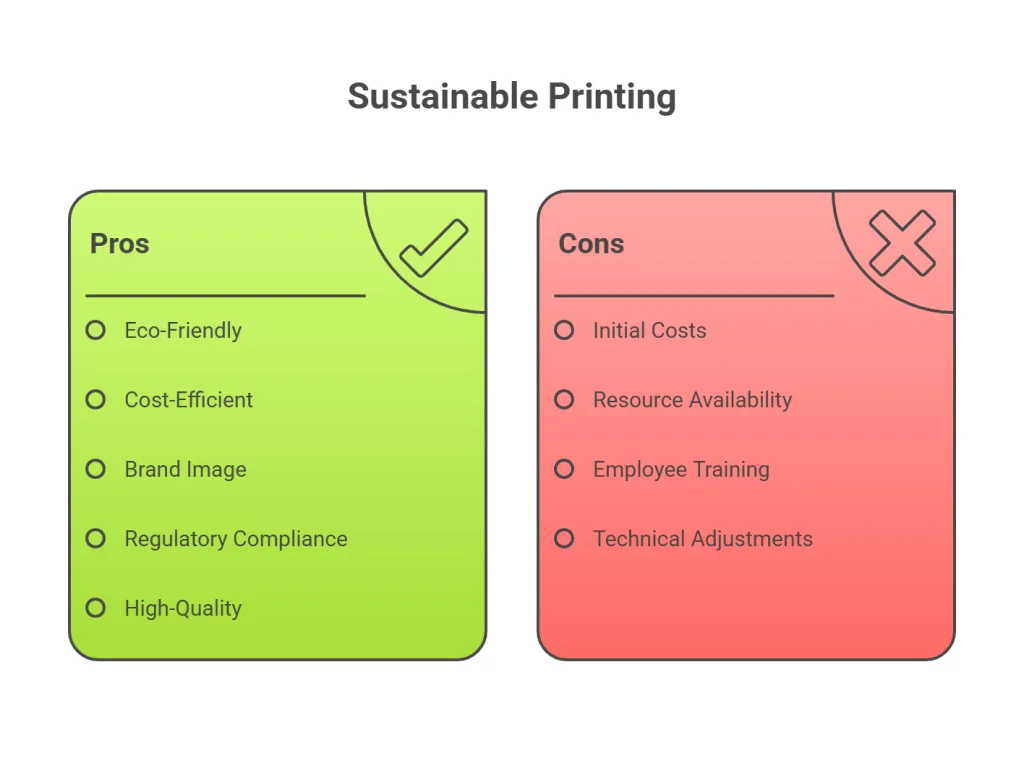
Challenges of Adopting Sustainable Printing
While the benefits are substantial, adopting conscious printing methods can have challenges
1. Higher Initial Costs:
Adopting eco-friendly methods—such as using recycled paper, vegetable-based inks, or energy-efficient equipment—can require a larger upfront investment compared to traditional printing. While these costs often pay off over time, they can be a barrier for businesses just starting out.
2. Limited Resource Availability:
Not every region has easy access to certified sustainable materials or green printing supplies. In some areas, it can be time-consuming or more expensive to source eco-friendly papers, inks, or equipment, making widespread adoption harder.
3. Need for Employee Training:
Making the switch means that teams must learn new processes, use unfamiliar equipment, and adapt to different materials. This may temporarily slow productivity as employees adjust and requires a commitment to staff education.
4. Technical and Quality Adjustments:
Some sustainable materials may react differently during printing. It can take extra effort to match the color, durability, or finish of conventional prints, and businesses may need to test and tweak processes to achieve the desired results.
Conclusion
Sustainable printing is continuously evolving to incorporate other technologies like 3D printing, algae-based inks and toners. These technologies will revolutionize the printing industry in the coming decades. For further assistance in industrial printing solutions, get in touch with Qodenext today.
FAQs – Sustainable Printing
1. What is sustainable printing, and why is it important?
It refers to eco-friendly practices that minimize waste, reduce emissions, and conserve resources. It’s important because it helps protect the environment while still meeting printing needs efficiently.
2. How does recycled paper contribute to sustainability?
Recycled paper reduces the demand for virgin pulp, conserving trees, water, and energy. It also diverts waste from landfills and supports the recycling industry.
3. Are soy-based inks as effective as traditional inks?
Yes, soy-based inks provide vibrant colors and excellent print quality while being biodegradable and producing fewer harmful emissions.
4. What industries benefit the most from carbon-free printing?
Industries like publishing, packaging, fashion (for screen printing), and manufacturing (for 3D printing) benefit greatly from printing practices.
5. Is eco-friendly printing cost-effective?
While the initial investment may be higher, green printing reduces waste, energy use, and compliance costs in the long run, making it cost-effective over time.
6. What is the role of waterless printing in sustainability?
Waterless printing conserves water and prevents the contamination of water sources with harmful chemicals, making it an essential printing method.
7. How can small businesses adopt green printing?
Small businesses can start by using recycled paper, digital printing, or partnering with eco-friendly printing services to reduce their environmental impact.

